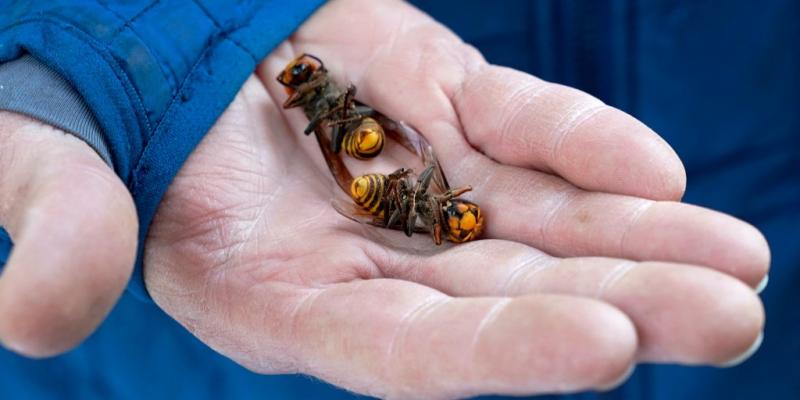Dead 'murder hornet' found near Seattle is first in U.S. this year



The 2-inch-long (5-centimeter-long) invasive insects, first found near the U.S.-Canadian border in December 2019, are native to Asia and pose a threat to honeybees and native hornet species. While not particularly aggressive toward humans, their sting is extremely painful and repeated stings, though rare, can kill.

How scientists tracked and destroyed the first U.S. murder hornet nest
The world's largest hornet is much more of a threat to honeybees that are relied on to pollinate crops. They attack hives, destroying them in mere hours and decapitating bees in what scientists call their "slaughter phase." How they got here from Asia is unclear, although it is suspected they travel on cargo ships.
"Hitchhikers are a side effect of all the commerce we do globally," said Sven Spichiger, an entomologist with the state Agriculture Department who is leading the fight to eradicate the hornets.
In the latest sighting, a resident found the dead hornet on his lawn near the city of Marysville and reported it June 4 to the state agency. Entomologists retrieved it June 8, reporting that it was very dried out and a male hornet.
Given the time of year, that it was a male and that the specimen was exceptionally dry, entomologists believe it was an old hornet from a previous season that wasn't discovered until now, officials said. New males usually don't emerge until at least July.
There is no obvious pathway for how the hornet got to Marysville, officials said.
"The find is perplexing because it is too early for a male to emerge," said Dr. Osama El-Lissy, deputy administrator for the U.S. Department of Agriculture's quarantine program.
El-Lissy said the federal agency would work with state officials "to survey the area to verify whether a population exists in Snohomish County."
Because it was found for the first time in that county and had different coloring than previously collected specimens in North America, the hornet was submitted to the federal Animal and Plant Health Inspection Service for final verification.
On June 11, entomologists confirmed it was an Asian giant hornet. DNA testing indicated the specimen appeared to be unrelated to the hornet introductions in Whatcom County or Canada.
Spichiger said the newly found hornet lacked orange bands on its abdomen and likely came from a country in southern Asia.
"This new report continues to underscore how important public reporting is for all suspected invasive species, but especially Asian giant hornet," he said.
In 2020, half of the confirmed Asian giant hornet sightings in Washington and all of the confirmed sightings in Canada came from the public, officials said.
"We'll now be setting traps in the area and encouraging citizen scientists to trap in Snohomish and King counties," Spichiger said. "None of this would have happened without an alert resident taking the time to snap a photo and submit a report."
The USDA has placed the giant hornets on the list of quarantine pests, giving Washington state more tools to help eradicate the invasive species.

Tags
Who is online
437 visitors

When it comes to bugs, where there are one there are a million more.
They have been trying to hunt the nests down by marking live ones and then using GPS so that they can follow them to the nest.
Glad I live in the Arizona desert and those critters don't like hot weather!
You are lucky. I am not sure how they would do in NY. But then again, our summers can be very hot.
I think the key difference is the humidity. Those hornets like and thrive in humid conditions. Most of the desert Southwest is hot and dry. Your neck of the woods tend to be hot and humid.
Have paper wasps on my place in Oz. Very aggressive with very painful stings. They attack as a group and one soon learns the "wasp dance". Have sprayed them and torn down their nests for years and they keep coming back. Keep a couple of cans of wasp spray by each door (inside and out) and one in the truck right next to the bear spray.
We get yellow jackets here in the desert guite frequently. I also have to keep spray on hand because they will nest very often in the eaves of my roof in the shade. Have to destroy nests at least once or twice a year.
Looks more like a murdered hornet.